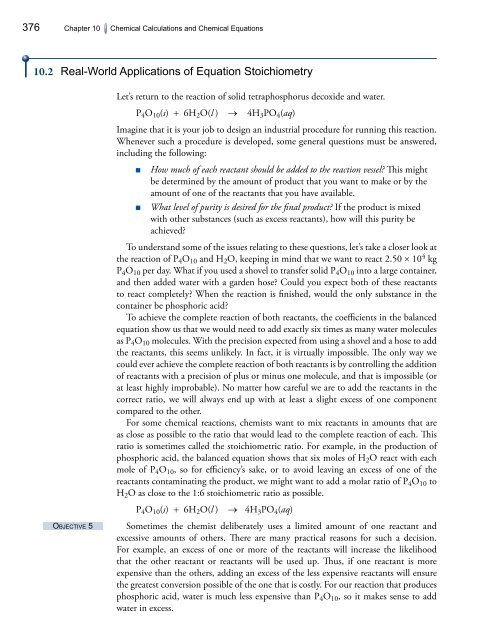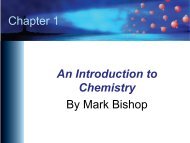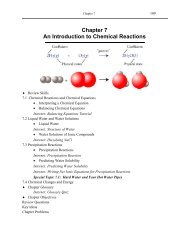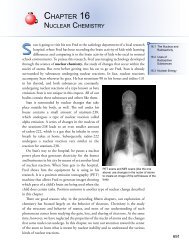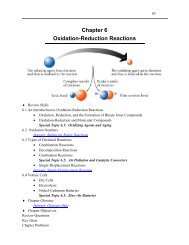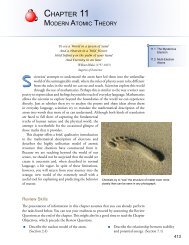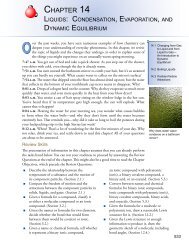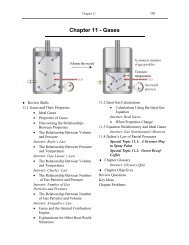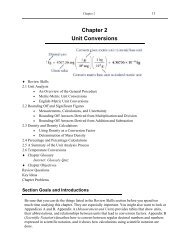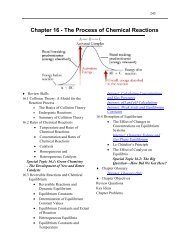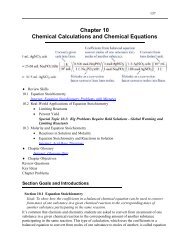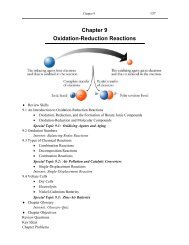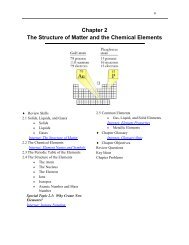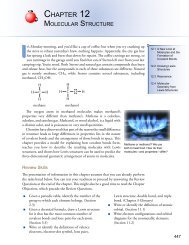Chapter 10 - An Introduction to Chemistry: Chemical Calculations ...
Chapter 10 - An Introduction to Chemistry: Chemical Calculations ...
Chapter 10 - An Introduction to Chemistry: Chemical Calculations ...
Create successful ePaper yourself
Turn your PDF publications into a flip-book with our unique Google optimized e-Paper software.
376 <strong>Chapter</strong> <strong>10</strong> <strong>Chemical</strong> <strong>Calculations</strong> and <strong>Chemical</strong> Equations<br />
<strong>10</strong>.2 Real-World Applications of Equation S<strong>to</strong>ichiometry<br />
Let’s return <strong>to</strong> the reaction of solid tetraphosphorus decoxide and water.<br />
P 4 O <strong>10</strong> (s) + 6H 2 O(l ) → 4H 3 PO 4 (aq)<br />
Imagine that it is your job <strong>to</strong> design an industrial procedure for running this reaction.<br />
Whenever such a procedure is developed, some general questions must be answered,<br />
including the following:<br />
How much of each reactant should be added <strong>to</strong> the reaction vessel? This might<br />
be determined by the amount of product that you want <strong>to</strong> make or by the<br />
amount of one of the reactants that you have available.<br />
What level of purity is desired for the final product? If the product is mixed<br />
with other substances (such as excess reactants), how will this purity be<br />
achieved?<br />
To understand some of the issues relating <strong>to</strong> these questions, let’s take a closer look at<br />
the reaction of P 4 O <strong>10</strong> and H 2 O, keeping in mind that we want <strong>to</strong> react 2.50 × <strong>10</strong> 4 kg<br />
P 4 O <strong>10</strong> per day. What if you used a shovel <strong>to</strong> transfer solid P 4 O <strong>10</strong> in<strong>to</strong> a large container,<br />
and then added water with a garden hose? Could you expect both of these reactants<br />
<strong>to</strong> react completely? When the reaction is finished, would the only substance in the<br />
container be phosphoric acid?<br />
To achieve the complete reaction of both reactants, the coefficients in the balanced<br />
equation show us that we would need <strong>to</strong> add exactly six times as many water molecules<br />
as P 4 O <strong>10</strong> molecules. With the precision expected from using a shovel and a hose <strong>to</strong> add<br />
the reactants, this seems unlikely. In fact, it is virtually impossible. The only way we<br />
could ever achieve the complete reaction of both reactants is by controlling the addition<br />
of reactants with a precision of plus or minus one molecule, and that is impossible (or<br />
at least highly improbable). No matter how careful we are <strong>to</strong> add the reactants in the<br />
correct ratio, we will always end up with at least a slight excess of one component<br />
compared <strong>to</strong> the other.<br />
For some chemical reactions, chemists want <strong>to</strong> mix reactants in amounts that are<br />
as close as possible <strong>to</strong> the ratio that would lead <strong>to</strong> the complete reaction of each. This<br />
ratio is sometimes called the s<strong>to</strong>ichiometric ratio. For example, in the production of<br />
phosphoric acid, the balanced equation shows that six moles of H 2 O react with each<br />
mole of P 4 O <strong>10</strong> , so for efficiency’s sake, or <strong>to</strong> avoid leaving an excess of one of the<br />
reactants contaminating the product, we might want <strong>to</strong> add a molar ratio of P 4 O <strong>10</strong> <strong>to</strong><br />
H 2 O as close <strong>to</strong> the 1:6 s<strong>to</strong>ichiometric ratio as possible.<br />
P 4 O <strong>10</strong> (s) + 6H 2 O(l ) → 4H 3 PO 4 (aq)<br />
Objective 5<br />
Sometimes the chemist deliberately uses a limited amount of one reactant and<br />
excessive amounts of others. There are many practical reasons for such a decision.<br />
For example, an excess of one or more of the reactants will increase the likelihood<br />
that the other reactant or reactants will be used up. Thus, if one reactant is more<br />
expensive than the others, adding an excess of the less expensive reactants will ensure<br />
the greatest conversion possible of the one that is costly. For our reaction that produces<br />
phosphoric acid, water is much less expensive than P 4 O <strong>10</strong> , so it makes sense <strong>to</strong> add<br />
water in excess.


